Three Points of Contact Residency is the pilot year of a roving residency that has brought together groups of regional artists from York, Glasgow and Cornwall with international artists von Calhau! from Portugal. The Calouste Gulbenkian Foundation has funded the initial research and the residency itself. We caught up with Jenny Brownrigg (The Glasgow School of Art Exhibitions Director) to find out more:
The residency has been a curatorial collaboration, devised by independent curator Judit Bodor in York; Blair Todd who is the curator from publicly funded institution The Exchange in Penzance; and myself, Exhibitions Director from higher education institution The Glasgow School of Art. We met on a curatorial research trip to Portugal and when wishing to work together, began to discuss the normal residency format where an artist would come to a new place and unless there were other artists in residency, may find it difficult to meet other artists in that community. This led to a period of research where we spoke to Portuguese curators and UK and Portuguese artists to begin to identify then test out the concept for this residency model.
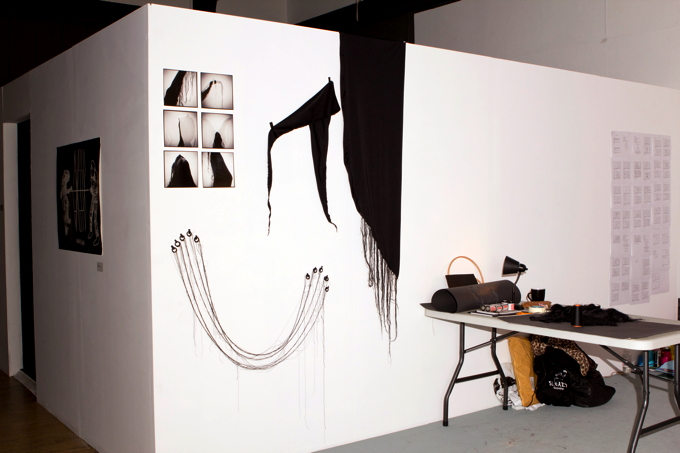
Hrafnhildur Halldórsdóttir’s studio space, Mackintosh Museum, GSA, Three Points of Contact Residency (2012)
An experimental residency, with no exhibition outcomes, the emphasis is rather on artists’ extending their networks by coming into contact with those from a different area and working alongside each other in a studio situation. The success can be gauged as much as in what happens after the residency, with new projects being forged between artists, as within its confines. Each residency takes place over a fortnight and is public facing. A group of core artists drawn from the three locations undertake their local residency and then travel to the residency at one of the other locations in the network. The international artists travel to all three locations. At each location a further number of regional artists join the group. The selected artists all have potential links in interests or process, or skills that may add a different dynamic to the group.
This model as in any curatorial model could have been like ‘The Bed of Procustes’ (publisher Penguin, 2010), where Nassim Talib re-tells the story of Procrustes who in Greek mythology ‘had a peculiar sense of hospitality: he abducted travellers, provided them with a generous dinner, then invited them to spend the night in a rather special bed’. He promised that the bed would be a perfect fit for the traveller. ‘Those who were too tall had their legs chopped off with a hatchet; those who were too short were stretched’. Eventually one traveller called Theseus made Procrustes lie in his own bed and chopped off his landlord’s head. Talib concludes that this aphorism is how we as humans ‘facing limits of knowledge and things we do not observe, the unseen and the unknown, resolve the tension by squeezing life and the world into crisp commoditized ideas, reductive categories, specific vocabularies and pre-packaged narratives’.
The residency has avoided any curatorial ‘pre-packaged’ narrative as it has taken on a life of its own at each venue, led by individuals, the group and the location. At the first location in York, which also had support from staff and facilities at York St John University, the social time and shared experience threaded through the time in the studio space located at The New School House Gallery and the evenings spent together as all visiting artists shared the same accommodation. Judit took the group to Spurn Point, a peninsula in Yorkshire, and this visit provided one of the focuses that the group kept on returning to. Initially, we the curators had envisaged collaboration might come through initial ideas workshops in the residency but we soon saw that this was too prescriptive and that any connections between the artists came more naturally through discussions about their own work or by the symbiosis of working alongside each other. Artists also worked against the grain and speed of the residency; von Calhau! with others began to play and slow down vinyl to 16rpm whilst they worked in order to slow down time. We find ourselves learning from each stage of the residency to the next. The residency in York concluded with a research exhibition, which instead of showing resolved artworks instead showed the material and documents collected by the group over the fortnight linked to developing new works including Super 8 films, performance for video, photography and sound performance.
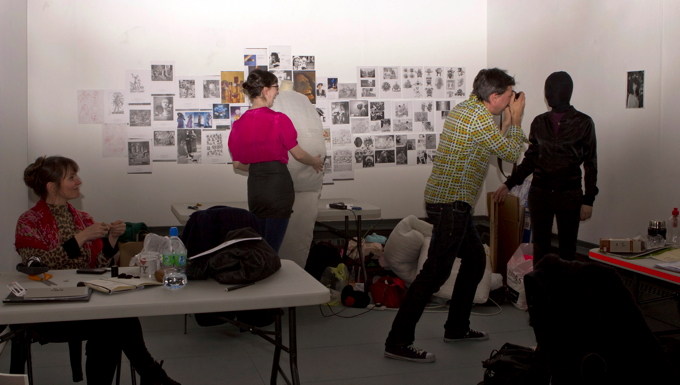
Jesse Leroy Smith (TAap) takes photograph of Michelle Hannah as Hrafnhildur Halldórsdóttir and Rachel Maclean look on. Mackintosh Museum, GSA, Three Points of Contact Residency (2012)
The Mackintosh Museum at The Glasgow School of Art was the second site of the residency. 100 years ago this space was the drawing studio, where all the plaster casts were sited, to be drawn by students learning their craft. Within the context of a Higher Education Institution it has been vital to test out what can happen when this exhibition space becomes a site for a studio. Yet it also holds the potential to be a key public space at the heart of the building and the institutional side of this curatorial desire was for this project to demonstrate the nature of the studio culture that forms the identity of this institution. The fact that this was the second part of the residency, which goes onto a third stage in Cornwall 15-26 January 2013, also reinforces that this institution faces outwards rather than inwards.
The Museum holds specific tensions for making work in. The life of the building ebbs and flows through this space; tour groups routinely pass through; students on their way to the studios; doors creak; the reception’s radio carries up through the stairwell. To combat this we built the studio space in the Mackintosh Museum with some open space but also ‘spaces of shelter’ including a black box room where the artists could show films on or make film work in.
Over the fortnight I became very self-aware of the perceived role of the curator and the role of the artists. Was it my role to quickly work through ‘tasks’ to resolve any issues that came up? Should scheduling and the basic requirements of the institutional context make way for a more people-specific approach? Should I hover to see what work was being made in order to analyse it or find a way to tell a story about it to the public? So often curators come in at the end stage of the process to carry forward finished works towards a re-interpretation. How should I react to the everyday challenges of working in such a community? The time became intense, with the human nature of all individuals involved becoming just as important as the work made. The creative process throws up the enlightenment when something works and the tension when something is unresolved. Creativity travels at different speeds. Issue-solving needs to sometimes step aside for tension to settle naturally in the time it takes. The vitality of a living process of making art brings with it the dialectic of both challenging versus channelling the creative space. As a co-curator on this project I greatly benefited from being able to discuss the residency with my curatorial peers.
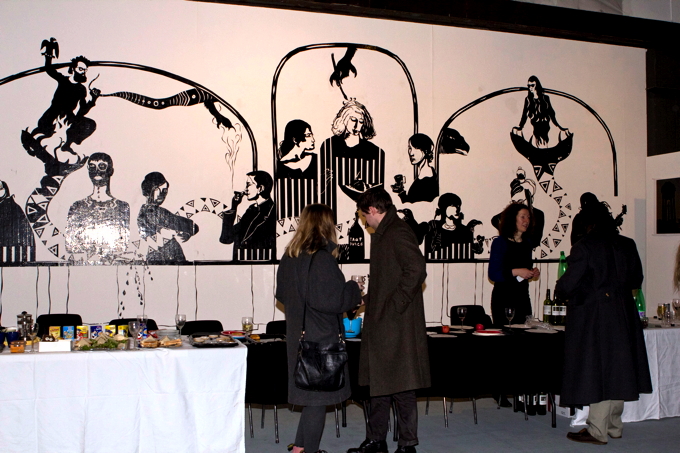
The Last Buffaye, TAap, Mackintosh Museum, GSA, Three Points of Contact Residency (2012)
‘The Last Supper’, the concluding event at the GSA, channelled much of the atmosphere of this residency and the museum space. TAap concluded their black gaffa tape rendition of the Last Supper on one wall of the Museum, creating a huge mural of the group of artists and curators involved, in ‘The Last Buffaye’. Von Calhau! with Stuart Gurden and Mark Vernon performed a version of Caledonia by Cromagnon, a 1960s’ USA experimental band who used primitive instruments such as sticks and stones. The sound lifted right up to the Arts & Crafts rafters, rendering a strangely monastic reading of the environment. Michelle Hannah showed ‘Sonne’, the film she had made during the residency where her rendition of The Smiths’ lyrics become ‘I am the Sun and the Air’. Above all, this all happened in the space of the studio, surrounded by artists’ areas of work including Rachel MacLean’s new costume for a forthcoming short film commission and Hrafnhildur Halldórsdóttir’s experiments in moving her handmade sculptural objects towards performative objects. Megan Wellington located ‘paradise’ through her conversations and photographs of stall holders and others encountered in the east end of Glasgow.
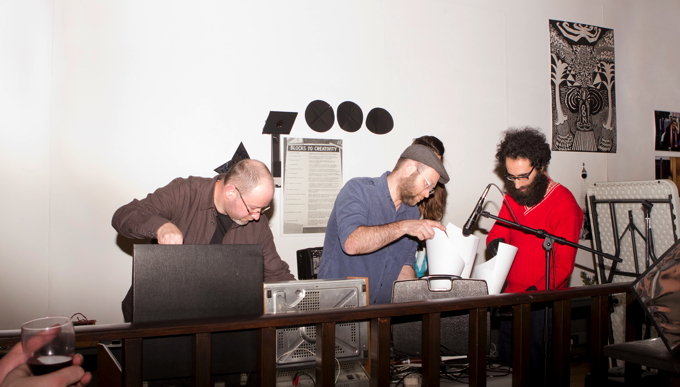
Mark Vernon, Stuart Gurden and von Cahau!, performance during ‘The Last Supper’, Mackintosh Museum, GSA, Three Points of Contact Residency 2012
As Marta from von Calhau! rang the Mackintosh ‘bell that does not ring’ in the atrium of the Mackintosh Museum, and played the studio table as a drum, it metaphorically ‘struck’ me that art is more about raw moments than outcomes. Through the commitment and leap of faith taken by all the artists and those involved Three Points of Contact Residency is providing an exhilerating enquiry into creativity and the conditions it requires. I look forward to witnessing the residency shift to the former telephone exchange at The Exchange, Penzance in January 2013 for the momentum to carry forward and a new set of connections to begin.
Check out residency artist, Michelle Hannah’s a blog post here.
*All photographs by Saule Zukaityte.
Where to find out more:
Website | Facebook | Twitter
//////
Want to take a look at more suggested blogs by artists? Look here.


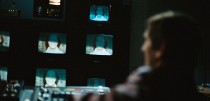











Comments